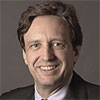Blindness and Emotion in the Market
Institutional investors are revered because they know more than the little guy. Indeed they always do, but knowledge does not always guarantee them better performance than the market gets as a whole, because in essence they are the market. They are subject to the same blindness and emotion as the rest of us. Humans are predisposed to seek out facts in the present, but we are poor at crafting these into descriptions befitting inflection points, or even during the considerable period of time that follows.
By nature most will fall back upon the comfort of possessing expert knowledge and be dismissive of almost any hypothesis well outside the range of current forecasts. The best kept secret is one that is told to everyone, but not believed (the verbal equivalent to Poe’s Purloined Letter ). Perhaps the reason is that collectively our ability to forecast, even among those who are emboldened to stake out turf outside the boundaries of evidence, is poor. Among us are too many boys crying wolf who are perennially wrong that the evidence-based majority of investors would reject any true prophet.
For those who have managed institutional money on Wall Street for decades, one of the most memorable outside-the-box forecasts came from First Boston strategist Suresh Bhirud, who in the spring of 1983, at a time when the Dow Jones Industrial Average was at 1,200, predicted correctly that it was headed much, much higher. Titled On a Clear Day You Can See 2,000, the research report seemed unbelievable, since the market had been stalled beneath 1,000 for about a decade.
On the other side of the coin is a graveyard filled with the intellects that have sought to challenge the wisdom of compounding credit growth at a rate significantly greater than real economic growth. There is a good reason for this: as Ibbotson and Sinquefield have shown, long-term returns of the stock market have been high, reflecting risk and a premium over inflation. From 1925 to 2007, large-cap stocks averaged a total return of 10.4 percent, while inflation was just 3 percent (using the official yardstick). There are no straightforward decision rules for asset allocation that can be gleaned from fundamental data that are stable and reliable over time; so the conventional wisdom is that it is best to stick with stocks unless you have some need for money in the next few years.
In the late 1980s, Charlie Minter and his partner Stan Selvigson warned of a coming credit crisis. Although they were utterly wrong, their convincing graphics and articulate commentary was welcomed (but rarely acted upon) by institutional investors weary of continuously upbeat forecasts from other strategists. This duo was among the most requested in the infotainment office-visit circuit run by the big brokers, which provided them a foundation for leaving their employer, Merrill Lynch, and forming Comstock Partners.
Public figures have mistakenly sounded the alarm of excessive speculation, too. In 1955, the Senate Banking Committee investigated the stock market, issuing a report concluding there was too much speculation, even though dividend yields on stocks were about 40 percent above those available in the bond market, indicating continued public wariness of equities caused by memory of the Great Depression. (Currently dividend yields are 60 percent lower than bond yields, and bond yields themselves are near record lows). Federal Reserve Chairman Alan Greenspan thought the stock market was giddy with “irrational exuberance” in December 1996, only to find it would ascend more rapidly than ever, by 27.6 percent annually from the beginning of 1997 through the end of 1999.
There is a long list of others who have bucked the conventional wisdom by being bearish. In fact, a cottage industry exists that exploits investor fears with dire predictions usually recommending ownership of gold coins or Treasury bills. They may have gained some converts during downturns, but each time the central bank has acted swiftly to spray more cheap credit out of its hose to put out the fire. With the exception of the malaise of the Jimmy Carter era, prolonged credibility has eluded those who would sound a systemic alarm.
[Editor’s note: This passage is reprinted from William W. Baker’s book, Endless Money: The Moral Hazards of Socialism, with the permission of John Wiley & Sons, Inc (©2010). You can get your own copy here.]


Comments: